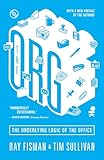The Org : The Underlying Logic of the Office - Updated Edition / Ray Fisman, Tim Sullivan.
Material type: TextPublisher: Princeton, NJ : Princeton University Press, [2015]Copyright date: ©2015Edition: Updated edition with a New preface by the authorsDescription: 1 online resource (328 p.)Content type:
TextPublisher: Princeton, NJ : Princeton University Press, [2015]Copyright date: ©2015Edition: Updated edition with a New preface by the authorsDescription: 1 online resource (328 p.)Content type: - 9780691166513
- 9781400866069
- 302.3/5 23
- HD58.7
- online - DeGruyter
- Issued also in print.
| Item type | Current library | Call number | URL | Status | Notes | Barcode | |
|---|---|---|---|---|---|---|---|
 eBook
eBook
|
Biblioteca "Angelicum" Pont. Univ. S.Tommaso d'Aquino Nuvola online | online - DeGruyter (Browse shelf(Opens below)) | Online access | Not for loan (Accesso limitato) | Accesso per gli utenti autorizzati / Access for authorized users | (dgr)9781400866069 |
Browsing Biblioteca "Angelicum" Pont. Univ. S.Tommaso d'Aquino shelves, Shelving location: Nuvola online Close shelf browser (Hides shelf browser)

|

|

|

|

|

|

|
||
| online - DeGruyter Strangers No More : Immigration and the Challenges of Integration in North America and Western Europe / | online - DeGruyter Analytical Psychology in Exile : The Correspondence of C. G. Jung and Erich Neumann / | online - DeGruyter The Antarctic Dive Guide : Fully Revised and Updated Third Edition / | online - DeGruyter The Org : The Underlying Logic of the Office - Updated Edition / | online - DeGruyter The Praise of Folly : Updated Edition / | online - DeGruyter The Muqaddimah : An Introduction to History - Abridged Edition / | online - DeGruyter The Great Mother : An Analysis of the Archetype / |
Frontmatter -- CONTENTS -- Preface to the Paperback Edition -- Introduction: A Machine for Getting Stuff Done -- CHAPTER 1: The Outsider -- CHAPTER 2: Designing the Job -- CHAPTER 3: Putting Together the Organizational Puzzle -- CHAPTER 4: In Praise of Squelching Innovation -- CHAPTER 5: What Management Is Good For -- CHAPTER 6: The View from the Corner Office -- CHAPTER 7: The Economics of Org Culture -- CHAPTER 8: Disaster and Change -- Conclusion: The Future Org -- ACKNOWLEDGMENTS -- NOTES -- INDEX -- ABOUT THE AUTHORS
restricted access online access with authorization star
http://purl.org/coar/access_right/c_16ec
We create organizations because we need to get a job done-something we couldn't do alone-and join them because we're inspired by their missions (and our paycheck). But once we're inside, these organizations rarely feel inspirational. So where did it all go wrong?In The Org, Ray Fisman and Tim Sullivan explain the tradeoffs that every organization faces, arguing that this everyday dysfunction is actually inherent to the very nature of orgs. The Org diagnoses the root causes of that malfunction, beginning with the economic logic of why organizations exist in the first place, then working its way up through the org's structure from the lowly cubicle to the CEO's office.You'll learn:The purpose of meetings and why they will never go awayWhy even members of al Qaeda are required to submit travel and expense reportsWhat managers are good forHow the army and other orgs balance marching in lockstep with fostering innovationWhy the hospital administration-not the heart surgeon-is more likely to save your lifeWhy CEOs often spend more than 80 percent of their time in meetings-and why that's exactly where they should be (and why they get paid so much)
Issued also in print.
Mode of access: Internet via World Wide Web.
In English.
Description based on online resource; title from PDF title page (publisher's Web site, viewed 30. Aug 2021)


